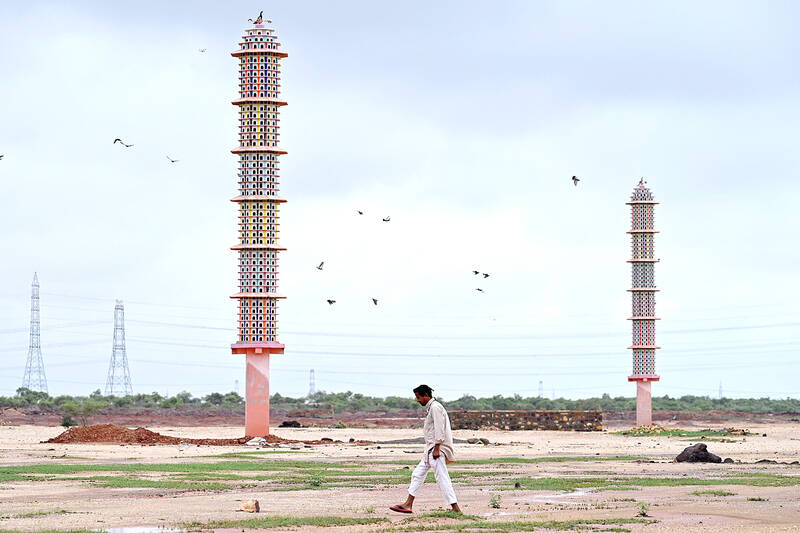Whirring wind turbines in India’s Thar desert supply critical green energy for the world’s most populous nation, but those living in their shadows say it comes at their expense.
It illustrates the hard balance faced as India, the third-largest greenhouse gas emitter, scrambles to boost its non-fossil fuel capacity to stem the rising impacts of climate change.
“The big companies have come here and built the windmills, but they’re useless to us,” said 65-year-old livestock herder Nena Ram, describing an age-old farming system upended by the giant turbines.

Photo: AFP
The nation is suffering increasing devastation from heat waves, floods and droughts, events that climate scientists say are exacerbated by rising global temperatures, but those from areas used for renewable energy production say their needs have been sacrificed for the greater good.
In western Rajasthan state, where most of the Thar desert lies, that includes the loss of grazing lands and damage to sacred groves called orans.
The desert oases, protected by the community for centuries, collect water critical for their livestock-based economy of camels, cattle and goats, but herders say heavy construction trucks damage the water sources, reducing grasslands and further drying the land.
What farmers like Ram contribute to greenhouse gases is very far from the fume-belching giants of India’s coal-hungry heavy industry.
He is struggling from a brutal one-two punch.
First he was hit by the consequences of climate change. Then he was knocked by mitigation efforts to combat them.
The deserts around Jaisalmer District in Rajasthan are dotted with hundreds of turbines, one of India’s largest onshore wind farms.
Rajasthan is capable of providing 5 gigawatts of wind power to the grid, according to Indian government figures.
Many turbines are owned by Indian conglomerates, including the Adani Group and Suzlon.
The companies say they are supporting India’s national drive to transition to renewable power while supporting communities impacted by the construction.
Suzlon says it provides “sustainable development to the villages around its wind farms,” including health, education and livestock support projects.
Adani says it is “deeply committed” to the community, supporting schools and clean water programs.
However, farmers complain bitterly that the turbines were built on community grazing land. Milk production has also slumped.
“The farmers are paying the price,” said Jitendra Kumar, who works in a local health clinic. “Their land was taken away. Windmills occupy the land meant for cattle grazing.”
Power lines crisscross the desert around Jaisalmer, a district home to about 670,000 people, according to the last census, but it suffers from frequent power cuts, sometimes for days at a stretch.
Residents say power is channeled to feed surging demand in industrial centers and big cities.
“We are leading our lives in darkness,” local environmental activist Sumer Singh Bhati said. “We have power for barely two hours a day... We are desperate for light.”
Power cuts are unbearable during summer. Temperatures sometimes sizzle at 50°C.
India this year baked in its longest heat wave on record, according to government weather experts.
They warn steadily more oppressive temperatures would be seen increasingly.
India aims to boost non-fossil fuel power capacity to 500 gigawatts by 2030 and is committed to achieving a net zero emissions economy by 2070 — two decades after most of the industrialized West.
Renewable energy plants are being built at breakneck speed, rising from 76 gigawatts to 203 gigawatts in the past decade, according to government data.
About one-quarter of that is from wind, but reaching the 500 gigawatts renewable target requires expansion on a vast scale.
Such statistics mean little to villagers living near the towering turbines, slamming them as an “incursion of the white structures.”
Environmental activists say that while outsiders see the desert as a dead zone, they are areas rich in biodiversity.
Locally revered species, such as the critically endangered great Indian bustard, are facing extinction.
The once common giant brown-and-white birds fly into the mesh of overhead power lines.
Parth Jagani, an environmental activist in Jaisalmer, said numbers had plummeted in the past 25 years — with just 150 left nationwide.
“Once the windmills and the high-tension wires were installed, their mortality increased,” Jagani said.
The Indian Supreme Court in 202 ordered power lines to be put underground in key bird breeding zones, but the government petitioned and overturned the decision, arguing it would hinder renewable energy targets.
Villagers have set up a memorial for the bird, a statue of a lone bustard.
“If our birds and animals are taken away, what will we do?” said Ram, smoothing his sweeping gray mustache. “How will we survive?”

Four people jailed in the landmark Hong Kong national security trial of "47 democrats" accused of conspiracy to commit subversion were freed today after more than four years behind bars, the second group to be released in a month. Among those freed was long-time political and LGBTQ activist Jimmy Sham (岑子杰), who also led one of Hong Kong’s largest pro-democracy groups, the Civil Human Rights Front, which disbanded in 2021. "Let me spend some time with my family," Sham said after arriving at his home in the Kowloon district of Jordan. "I don’t know how to plan ahead because, to me, it feels

‘A THREAT’: Guyanese President Irfan Ali called on Venezuela to follow international court rulings over the region, whose border Guyana says was ratified back in 1899 Misael Zapara said he would vote in Venezuela’s first elections yesterday for the territory of Essequibo, despite living more than 100km away from the oil-rich Guyana-administered region. Both countries lay claim to Essequibo, which makes up two-thirds of Guyana’s territory and is home to 125,000 of its 800,000 citizens. Guyana has administered the region for decades. The centuries-old dispute has intensified since ExxonMobil discovered massive offshore oil deposits a decade ago, giving Guyana the largest crude oil reserves per capita in the world. Venezuela would elect a governor, eight National Assembly deputies and regional councilors in a newly created constituency for the 160,000

North Korea has detained another official over last week’s failed launch of a warship, which damaged the naval destroyer, state media reported yesterday. Pyongyang announced “a serious accident” at Wednesday last week’s launch ceremony, which crushed sections of the bottom of the new destroyer. North Korean leader Kim Jong-un called the mishap a “criminal act caused by absolute carelessness.” Ri Hyong-son, vice department director of the Munitions Industry Department of the Party Central Committee, was summoned and detained on Sunday, the Korean Central News Agency (KCNA) reported. He was “greatly responsible for the occurrence of the serious accident,” it said. Ri is the fourth person

Poland is set to hold a presidential runoff election today between two candidates offering starkly different visions for the country’s future. The winner would succeed Polish President Andrzej Duda, a conservative who is finishing his second and final term. The outcome would determine whether Poland embraces a nationalist populist trajectory or pivots more fully toward liberal, pro-European policies. An exit poll by Ipsos would be released when polls close today at 9pm local time, with a margin of error of plus or minus 2 percentage points. Final results are expected tomorrow. Whoever wins can be expected to either help or hinder the